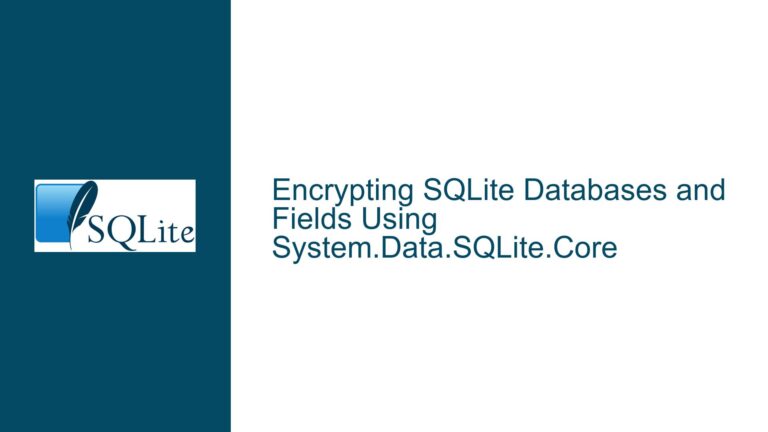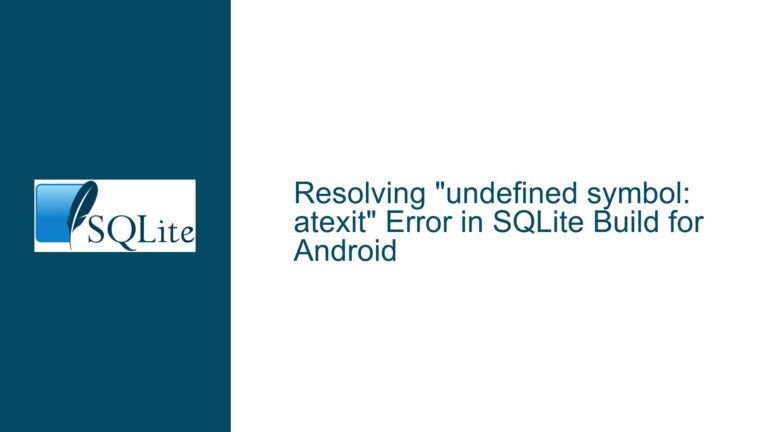Accessing sqlite3_sql APIs from Authorization Callback: Limitations and Workarounds
Understanding the Authorization Callback Mechanism in SQLite
The authorization callback in SQLite, set via the sqlite3_set_authorizer function, is a powerful feature that allows developers to control and monitor database operations at a granular level. This callback is invoked during the preparation phase of SQL statements, enabling the application to authorize or deny specific actions such as reading, writing, or altering database objects. The callback receives several parameters, including an action code and additional details about the operation being performed. However, one of the key limitations of the authorization callback is its inability to directly access the sqlite3_sql, sqlite3_normalized_sql, or sqlite3_expanded_sql APIs. These APIs are designed to provide the SQL text associated with a prepared statement, which can be particularly useful for debugging, logging, or implementing advanced security measures.
The primary reason for this limitation is the timing of the authorization callback invocation. The callback is called during the preparation phase of a SQL statement, which occurs before a valid statement handle is available. At this stage, the SQL text is still being parsed and validated, and the final form of the statement may depend on the decisions made by the authorization callback itself. For example, if the callback disallows access to a specific column, the resulting SQL statement may be modified to exclude that column. This dynamic nature of SQL statement preparation makes it impossible to provide a stable statement handle to the authorization callback.
Exploring the Constraints of Authorization Callbacks in SQLite
The constraints of the authorization callback mechanism in SQLite stem from its design and the sequence of operations during SQL statement preparation. When a SQL statement is prepared, SQLite first parses the statement and then invokes the authorization callback to determine whether the operation should be allowed. The callback is passed an action code and additional parameters that describe the operation, but it does not have access to the full context of the SQL statement being prepared. This is because the statement handle, which would provide access to the SQL text via sqlite3_sql or similar APIs, is not yet available at this stage.
The absence of a valid statement handle during the authorization callback means that developers cannot directly inspect the SQL text or its normalized form. This limitation can be particularly challenging when trying to implement advanced security measures, such as a "protected" list of pre-authorized parameterized SQL statements. Without access to the SQL text, it is difficult to compare the incoming SQL statement against the list of pre-authorized statements, making it harder to prevent the execution of arbitrary or malicious SQL.
Furthermore, the dynamic nature of SQL statement preparation adds another layer of complexity. The final form of the SQL statement may depend on the decisions made by the authorization callback. For example, if the callback disallows access to a specific column, the resulting SQL statement may be modified to exclude that column. This means that the SQL text available after preparation may differ from the original text, making it even more challenging to implement security measures based on the SQL text.
Implementing Workarounds for Accessing SQL Text in Authorization Callbacks
Given the limitations of the authorization callback mechanism in SQLite, developers must employ alternative strategies to achieve similar functionality. One possible approach is to use a combination of pre-statement and post-statement hooks to capture and inspect the SQL text. The sqlite3_preupdate_hook and sqlite3_update_hook functions can be used to monitor changes to the database, but these hooks do not provide direct access to the SQL text either. Instead, developers can use these hooks in conjunction with custom logging or tracking mechanisms to capture the SQL text before and after execution.
Another approach is to implement a custom SQL parser or preprocessor that intercepts SQL statements before they are passed to SQLite. This preprocessor can inspect the SQL text, compare it against a list of pre-authorized statements, and either allow or deny the operation based on the comparison. While this approach requires additional development effort, it provides greater flexibility and control over the SQL statements being executed.
In addition to these workarounds, developers can also leverage SQLite’s built-in features to enhance security and control. For example, the sqlite3_prepare_v2 function can be used to prepare SQL statements with additional options, such as enabling or disabling specific features. The sqlite3_trace and sqlite3_profile functions can be used to log SQL statements and their execution times, providing valuable insights into the database operations.
Ultimately, while the authorization callback mechanism in SQLite has its limitations, developers can still achieve advanced security and control by combining built-in features with custom solutions. By understanding the constraints and exploring alternative approaches, developers can implement robust security measures that protect against arbitrary or malicious SQL execution.
Detailed Analysis of the Authorization Callback Mechanism
The authorization callback mechanism in SQLite is a critical component for implementing fine-grained access control and monitoring. When a SQL statement is prepared, SQLite invokes the authorization callback to determine whether the operation should be allowed. The callback is passed several parameters, including an action code and additional details about the operation. The action code specifies the type of operation being performed, such as reading a column, updating a table, or creating an index. The additional parameters provide context for the operation, such as the name of the table or column being accessed.
One of the key challenges with the authorization callback mechanism is its timing. The callback is invoked during the preparation phase of a SQL statement, which occurs before a valid statement handle is available. This means that the callback does not have access to the SQL text or its normalized form, making it difficult to implement advanced security measures based on the SQL text. For example, if a developer wants to compare the incoming SQL statement against a list of pre-authorized statements, they would need access to the SQL text to perform the comparison. However, since the statement handle is not available during the callback, this is not possible.
Another challenge is the dynamic nature of SQL statement preparation. The final form of the SQL statement may depend on the decisions made by the authorization callback. For example, if the callback disallows access to a specific column, the resulting SQL statement may be modified to exclude that column. This means that the SQL text available after preparation may differ from the original text, making it even more challenging to implement security measures based on the SQL text.
Exploring Alternative Approaches for SQL Text Inspection
Given the limitations of the authorization callback mechanism, developers must explore alternative approaches to inspect and control SQL statements. One such approach is to use a custom SQL parser or preprocessor that intercepts SQL statements before they are passed to SQLite. This preprocessor can inspect the SQL text, compare it against a list of pre-authorized statements, and either allow or deny the operation based on the comparison. While this approach requires additional development effort, it provides greater flexibility and control over the SQL statements being executed.
Another approach is to use SQLite’s built-in tracing and profiling features to capture and log SQL statements. The sqlite3_trace function can be used to log SQL statements as they are executed, providing a record of all database operations. The sqlite3_profile function can be used to log the execution time of SQL statements, providing insights into the performance of the database. By combining these features with custom logging or tracking mechanisms, developers can gain greater visibility into the SQL statements being executed and implement more robust security measures.
In addition to these approaches, developers can also leverage SQLite’s virtual table mechanism to implement custom security controls. Virtual tables allow developers to define custom table implementations that can intercept and modify database operations. By creating a virtual table that inspects and controls SQL statements, developers can implement advanced security measures that are not possible with the standard authorization callback mechanism.
Implementing a Custom SQL Preprocessor for Advanced Security
One of the most effective ways to overcome the limitations of the authorization callback mechanism is to implement a custom SQL preprocessor. This preprocessor can intercept SQL statements before they are passed to SQLite, inspect the SQL text, and compare it against a list of pre-authorized statements. If the SQL statement matches a pre-authorized statement, the preprocessor can allow the operation to proceed. If the SQL statement does not match any pre-authorized statements, the preprocessor can deny the operation or raise an error.
The custom SQL preprocessor can be implemented as a separate component that sits between the application and the SQLite database. When the application prepares a SQL statement, it first passes the statement to the preprocessor for inspection. The preprocessor can use a variety of techniques to compare the SQL statement against the list of pre-authorized statements, such as string matching, regular expressions, or even a full SQL parser. Once the preprocessor has determined whether the SQL statement is authorized, it can either allow the operation to proceed or raise an error.
Implementing a custom SQL preprocessor requires a deep understanding of SQL syntax and semantics, as well as the ability to parse and analyze SQL statements. However, the effort required to implement a preprocessor can be justified by the increased security and control it provides. By intercepting and inspecting SQL statements before they are executed, developers can prevent the execution of arbitrary or malicious SQL and ensure that only authorized operations are performed on the database.
Leveraging SQLite’s Built-in Features for Enhanced Security
In addition to implementing custom solutions, developers can also leverage SQLite’s built-in features to enhance security and control. For example, the sqlite3_prepare_v2 function can be used to prepare SQL statements with additional options, such as enabling or disabling specific features. The sqlite3_trace and sqlite3_profile functions can be used to log SQL statements and their execution times, providing valuable insights into the database operations.
Another built-in feature that can be used to enhance security is SQLite’s virtual table mechanism. Virtual tables allow developers to define custom table implementations that can intercept and modify database operations. By creating a virtual table that inspects and controls SQL statements, developers can implement advanced security measures that are not possible with the standard authorization callback mechanism.
For example, a virtual table could be created that inspects all SQL statements before they are executed and compares them against a list of pre-authorized statements. If the SQL statement matches a pre-authorized statement, the virtual table can allow the operation to proceed. If the SQL statement does not match any pre-authorized statements, the virtual table can deny the operation or raise an error. This approach provides a high level of security and control, while still leveraging the power and flexibility of SQLite.
Conclusion: Balancing Security and Flexibility in SQLite
The authorization callback mechanism in SQLite provides a powerful tool for implementing fine-grained access control and monitoring. However, its limitations, particularly the inability to access the SQL text during the callback, can make it challenging to implement advanced security measures. By understanding these limitations and exploring alternative approaches, developers can achieve the desired level of security and control while still leveraging the power and flexibility of SQLite.
Implementing a custom SQL preprocessor or leveraging SQLite’s built-in features, such as virtual tables and tracing functions, can provide the necessary tools to inspect and control SQL statements. While these approaches require additional development effort, they offer greater flexibility and control, enabling developers to implement robust security measures that protect against arbitrary or malicious SQL execution.
Ultimately, the key to successfully implementing advanced security measures in SQLite lies in understanding the constraints of the authorization callback mechanism and exploring alternative approaches that provide the necessary functionality. By combining built-in features with custom solutions, developers can achieve a balance between security and flexibility, ensuring that their applications are both secure and efficient.






